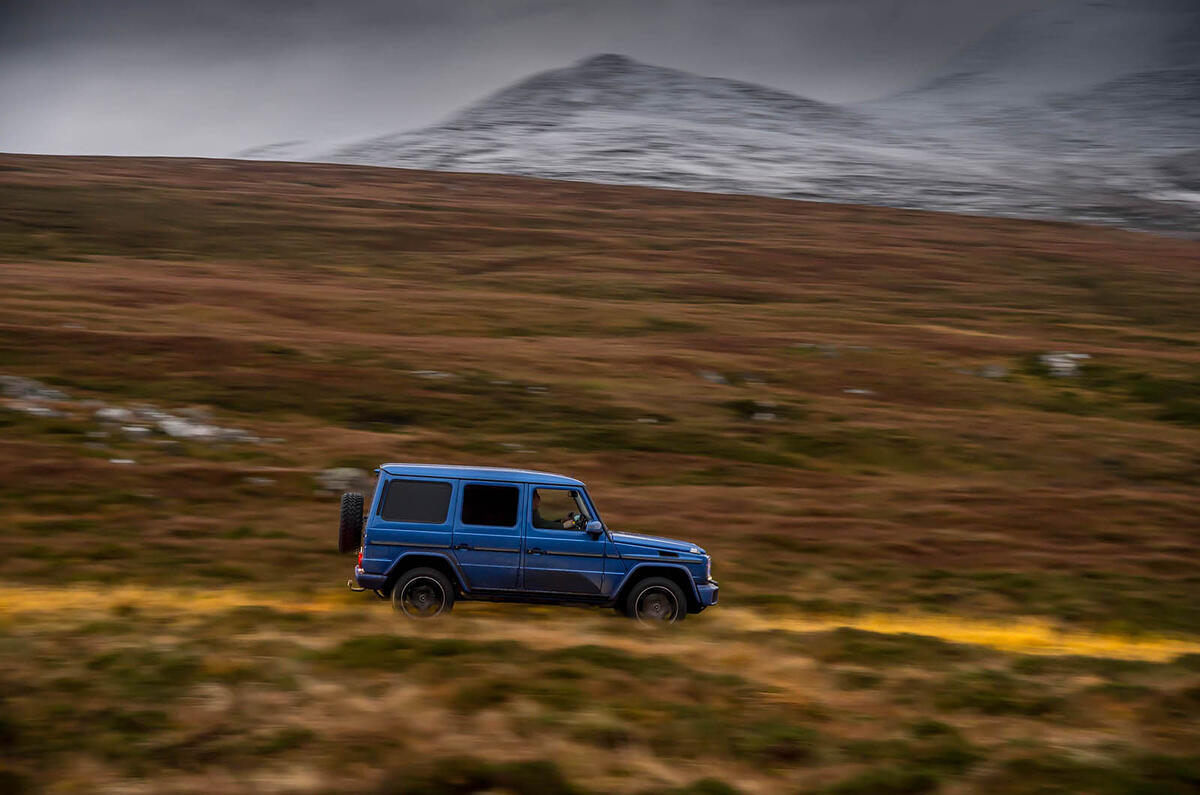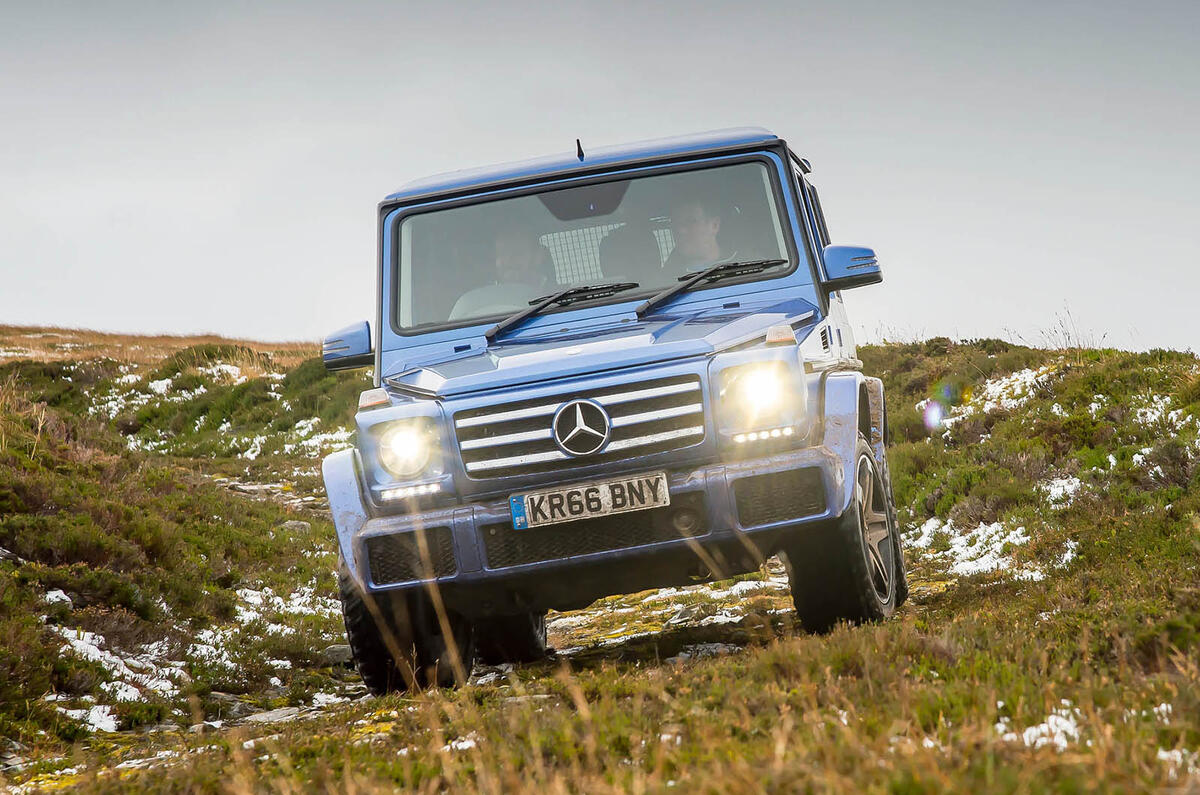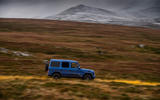The Mercedes-Benz G-Class could be tough enough to cross the entire country off-road. We find out if it's doable.
Is it cheating? It feels like it might be cheating.
We have a plan, see, and it is this: to drive from one side of Britain to the other. No big deal. Even at its widest, to go from west Wales to East Anglia, you could be looking at a 400-mile journey.
Which wouldn’t necessarily be a problem, were the plan to use public roads. There’d be some B-roads and a spot of M4, M25 and A12 and the job would be about done.
But what I’d like to do is drive from one side of this scepter’d isle to the other without using the public highway at all. And you can’t cross Britain without using public roads, you see, if your route includes the home counties, as you’ll know if you’ve ever tried to find a Byway Open to All Traffic in Oxfordshire.

So we’re going further north, to where Britain is narrower. Half an hour north of Inverness, in Scotland, is about as far north as you can go before it would definitely be cheating; driving from one side of John O’Groats car park to the other isn’t ‘coast to coast’. Up here, the width of our island is more baton or twig than sceptre, so there’s far more chance of success.
In this part of Scotland, getting from coast to coast is no more than about 65 miles, especially if you start, as I’m doing, in a location that looks slightly inland of the very eastern edge – albeit still connected to the sea – on the shores of the Cromarty Firth. The plan is to head west from here, all off road, until we finish near the west coast at Ullapool, on the banks of Loch Broom, also within sight of the sea.
It’s the hard way, after all. Public highways were in existence before the motor car and have since become the standard way to get around in a car, for obvious reasons of convenience and so on. Coast to coast up here, on the road, would take about an hour and a half on the A385. We’ve banked two days to get it done in the rough.
This coast-to-coast journey has never been done in a vehicle before, off the public highway, according to Mercedes-Benz, which has laid the plans. Not since 1941 has a column of German vehicles hoped to travel from the east coast across… well, that’s not important. Even these plans have been damnably hard to sort: two years in the making.
There are no obvious byways connecting one edge to another, even this far north, which means that 11 different landowners have had to give their permission. They’ve agreed for different reasons: one so he can build awareness of his plan to reintroduce native forest to the area, along with the wolves (although as few as five of them will want 50,000 acres in which to roam) and eventually bears that go with it; some because they’re gaming estates and allowing access is what they do. Bridges – figuratively and literally – have had to be built to get it agreed. Literal boulders that were put in place specifically to stop people illegally driving across estates have had to be removed. The organiser has begged that I don’t reveal the precise, specific route, for those reasons. So I won’t.

Even so, there are three stretches where metalled highway is unavoidable. Network Rail was immovable, so to avoid even the slightest potential for a Mercedes-locomotive interface, we have to circumnavigate a railway line on the east coast almost as soon as we start. Then there is one piece of land with an unconquestable cliff face unless you take the less scenic asphalt route. And there is no other way to get the last few hundred yards to the finish line – on an Ullapool golf course – other than via the high street.
A few pieces of cheatery-fudgery, then. The three very short roads in question have been closed, so they are not open ‘public’ highway. One section is closed for a ‘procession’, which feels slightly immodest when led by a piper. The second section is closed for a regularity rally, with a 17mph target average speed (a contest your correspondent wins, you’ll be reassured to know), and the final road is shut so that the farmer can drive her sheep along the road between fields, using a few border collies – and a Mercedes 4x4.
It is, I will not lie, a magnificent journey of breathtaking scenery and challenging terrain. However, that is presumably of no comfort to you at all, given that you cannot do the same journey unless you’re on foot and, even then, soon enough, you’ll have to be on the lookout for wolves. Judith Chalmers never admitted that doing these things is rather more fun than hearing about it, but I’m prepared to accept it. Of more relevance to you, then, is the vehicle we’re doing it in.

And that definitely is cheating. No crossover or lightweight off-roader for us. The car we’re going to do it in is a Mercedes-Benz G-Class. Since the death of the Land Rover Defender, I reckon there are only two of these ‘original old-school’ off-roaders left on sale: the Jeep Wrangler and the G-Class (although there’s an argument for the Lada Niva, too). No, of course I don’t have a scientific or technological basis for my argument. It’s just how it feels to me. All other cars have had vast step changes during their lives. Things like the G-Class, the Wrangler, a Morgan and a Caterham are different. Even if the modern G-Class shares no more with its first predecessor than, say, a Toyota Land Cruiser does, I’m sticking with my instinct.
The G-Class’s predecessors, then. The G-Class was born in 1979 as the G-Wagen, or Geländewagen, which translates into English as ‘cross-country vehicle’. Then, as now, it had a separate ladder-frame chassis and is a serious off-roader. It has done agriculture, but never in the same fashion as a Land Rover. It wasn’t just a tractor unit with various bolt-on bodystyles, although it was versatile. Just a year into its life, the pope had a converted one.
Then, as now, it was built in Graz, Austria, at what was the Steyr-Daimler-Puch factory. There have been facelifts, but although people are starting to use the words ‘legendary’ and ‘iconic’, when it comes to it, there are two things to note. First is that, in the scheme of things, it has been a relatively slow burn. Only 250,000 have been built in its history, and 2016 was its record production year, with more than 20,000 being made for the first time.
Second is that there is seemingly no end to it. The G-Class is a niche product by Mercedes sales volumes but, even so, they like it and plan a future for it. As well they might, given that the base price for a 3.0-litre V6 diesel G350d in the UK is £88,800 before options. At that price – or the considerably greater amount that a lot of regions will spend on uprated G350ds and AMG models – it’s business well worth having. Still, around 180 G-Classes find homes every year in the UK, with 60% of them being AMGs.
The secret of its success is that it has moved with the times, and moved convincingly, and Mercedes says there is no end in sight. Had similar investment in keeping the Defender relevant been made, you wonder if Land Rover might have felt the same about keeping it going.

Inside, a modern G-Class, although still bearing the cabin narrowness and tall driving position that gives its age away, is made from seriously plush materials – plush as a Defender never was, even when modified. Its 38-year-old roots sometimes show through. It retains a slow, recirculating-ball steering set-up and a jiggly ride, but neither makes it unpleasant to drive, on road or off. And the compact width, compared with modern stuff, makes it easy to thread along tight tracks.
And off road, it’s still mega. It has a low-ratio transfer case and lockable front, middle and rear differentials. Our car was on gloop-ready tyres, admittedly, but not once in 65 miles of off-roading – ranging from light, to quite serious, to bog that would be impenetrable were it not for a legion of crawl boards – did it get stuck. The seven-speed automatic gearbox shifts smoothly and the engine is audible, unsurprisingly, but being a 3.0-litre V6, it lets out a refined grumble as it mooches powerfully around its rev range.
There are, in short, few better cars for this journey. It’s a difficult journey – logistically and technically – and now that it’s over, bridges have been taken down and boulders replaced and it’s unlikely to be done again. But unique, challenging and unrepeatable are all words that fit a G-Class.




































































Join the debate
Add your comment
Exactly which east cost did a
..
Looks like fun.
On any expensive SUV review, can you just put the name in the headline, post a couple of pictures and ditch the journalism? Not that I have any problem with the journalism, I think it is rather good, it's just it gets in the way of the comments which are so hilarious.
For reference, check out any landrover article (yes I know this is Mercedes, but the same rule applies) can be followed by comments where someone hates suvs, another likes the blingy grille, someone takes offence, another winds someone up, someone makes an environmental point, and someone bangs on about towing horseboxes/trailers. Brilliant. Better than any crappy soap on tv.
The mercedes g spot comments just need to ferment for a couple of days to reach the above criteria.